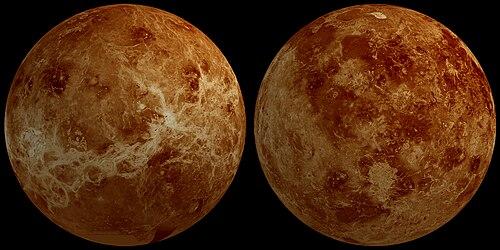Venus Reveals Unexpected Geological Activity
In a remarkable turn of events, researchers have potentially identified signs that Venus, once deemed a lifeless geological entity, may still be experiencing geological activity. A fresh examination of NASA’s data gathered over three decades ago has reignited interest in the planet’s dynamic nature. By meticulously analyzing this historical information, scientists have uncovered fascinating indicators that suggest Venus could be undergoing processes typically linked to tectonic movements. This emerging viewpoint not only challenges long-standing beliefs about our neighboring planet but also paves the way for further scientific inquiry.
The most striking evidence comes from the analysis of radar data collected during NASA’s Magellan mission between 1990 and 1994. This re-evaluation suggests that Venus might not be as dormant as previously thought; instead, it could still be shaped by significant geological forces. Researchers are now positing that active processes, including volcanic eruptions and tectonic shifts, may continue to influence its surface.
Key findings include:
- Surface Changes: Evidence of terrain alterations indicates recent geological activity.
- Heat Signatures: Regions with elevated temperatures point towards ongoing volcanic phenomena.
- Lava Flow Indicators: Observations resembling lava flows suggest potential volcanic eruptions.
| Geological Feature | Importance |
|---|---|
| Terrain Alterations | Possible signs of active geology at work |
| Eruptive Heat Areas | Suggests active volcanism on the planet’s surface |
NASA Data Reanalysis Challenges Established Theories About Planetary Surface Dynamics
The latest scrutiny of NASA’s extensive records regarding Venus has revived discussions about its potential geological vitality. Historically viewed as a static world marked by ancient lava flows and dormant volcanoes, new interpretations indicate certain areas on Venus might still host active geological mechanisms—contradicting previous assumptions. Utilizing advanced imaging techniques on data from the Magellan mission in the early ’90s has unveiled possible indicators of ongoing volcanic activity , alongside notable surface deformations.
This groundbreaking research raises essential questions regarding how we perceive Venus’s evolution and history:
- Detailed Surface Analysis: Enhanced radar imaging reveals changes in surface features over time frames previously unconsidered.
- Eruption Potential: The presence of possibly active volcanoes suggests continuous geologic processes similar to those observed on Earth.
- Aerosol Interactions:The impact of volcanism on atmospheric conditions is being reevaluated based on these findings.
| Main Findings | Your Implications for Future Research? | |
|---|---|---|
| Active Geological Features | Reinforces theories surrounding planetary dynamism | |
| Transform previous understandings | tr > | |
| Encourages renewed focus on studying Venus | tr > |
Future Exploration: Implications for Upcoming Missions to Venus
The insights gained from reanalyzing decades-old NASA data imply that our understanding of Venus as an inactive body may need revision. These discoveries open exciting possibilities for future planetary exploration focused specifically on its geologic activities—potentially revealing evidence supporting ongoing volcanism and tectonics.
The key implications for forthcoming missions include:
- < strong >Focus Shift Towards Geology:< / strong > Future missions should emphasize comprehensive surveys aimed at uncovering details about both surface and subsurface dynamics.< / li >
- < strong >Utilization Of Advanced Imaging:< / strong > Employing high-resolution imaging technologies can help identify previously overlooked volcanic structures.< / li >
- < strong >Direct Measurements:< / strong > Collecting real-time data from the planet’s surface will enhance our understanding regarding heat flow patterns along with gas emissions related to current geologic activities.< / li >
< ul >This research holds significance beyond mere academic curiosity; comprehending how geology operates within environments like those found in other planets can yield valuable insights into terrestrial evolution—including Earth itself! Comparative studies across different celestial bodies could deepen our grasp concerning planetary formation mechanisms while enhancing knowledge surrounding dynamic systems overall! To effectively tackle these objectives moving forward requires collaborative international efforts pooling resources together maximizing scientific output! A proposed timeline outlining future missions might look something like this:
p >< th>Missions Phases Description Date Range tr > < td > Concept Development < td > Define mission goals & tech needs < td > 2024 – 2025 < td > tr /> < td > Design & Testing < td > Create instruments & test methods for gathering info. < td > 2026 – 2028 < td > tr /> < td>< ;Launch> ;< ;/ Launch> ;< ;/ Launch> ;>>>>>
< tbody />
